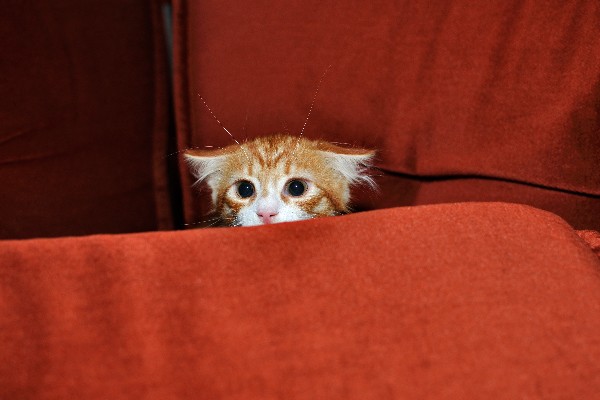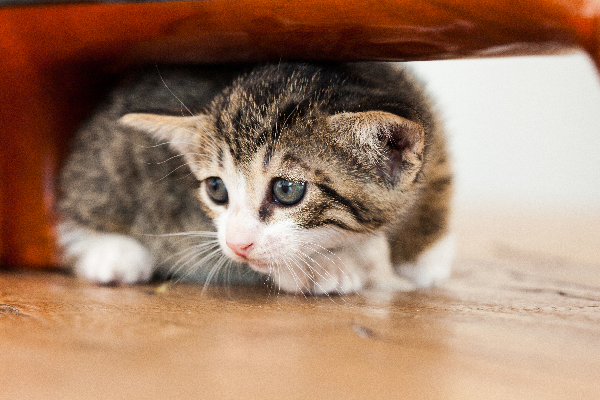Fraidy-cat and scaredy-cat are frequently used terms defined by Merriam Webster Dictionary as “someone who is very afraid of something” and “an unduly fearful person,” respectively. As a cat parent, I feel this is unjust — there’s no fraidy-dog or scaredy-hound in our lexicon. The irony is, my greatest household fears, like finding a spider or mouse, are calling cards for a rousing round of feline fun. But, when I touch the vacuum, my cats scatter like I would if I was ankle-deep in arachnids. So, what are cats scared of? And, more importantly, how can we help them overcome their fears? Let’s find out!
Before answering “What are cats scared of?” let’s look at why cats get scared in the first place.

From an evolutionary standpoint, a healthy amount of fear keeps the lineage going. Nathan L. Letts, PH.D., in a blog on Psychology Today, states that there is a basic fearful reflex ingrained in many animals at birth. And cats come with a lifesaving lion’s share of fearful triggers.
Some seem rational and many seem less so. So, why are cats so scared a lot of the time? Aren’t they considered predators? Perhaps, but they’re not at the apex. “Cats can be afraid of almost anything that is unfamiliar or has threatening qualities — it’s important to remember that although cats are predators, they are ‘mesopredators,’ meaning they are not at the top of the food chain,” says Dr. Mikel Delgado, Ph.D., and Certified Cat Behavior Consultant at Feline Minds. “They can also be prey, so it just makes good sense for cats to be cautious when it comes to unfamiliar experiences.”
I recently had a conversation with an adopter of a shyer cat who had an “a-ha” moment. The new pet parent was getting the kitty acclimated to his home and keeping her in one room (as per expert advice). She was slowly becoming friendlier, but he removed the bed frame so she couldn’t hide. This minor difference was a major change for the kitty and set the cat back to day one.
So, it’s imperative to know what triggers fear in our kitties. To us, the following items may seem like ridiculous things to be afraid of. But Dr. Delgado warns, “To the cat, the fear is very real — it may feel like life or death. A lot of aggressive behaviors stem from fear.”

The top 6 things that frighten cats:
1. New people
Aka the vanishing cat of game night.
2. New family members.
Introducing your cat to a new cat, dog or baby, needs to take place slowly because the new dynamic is scary to them.
3. Loud appliances.
Household objects like vacuums, blenders, washers/dryers and blow-dryers can send cats scampering.
4. Going to the veterinarian.
Moving outside their familiar territory scares many cats.
5. Moving to a new home.
A mind-blowing experience that scares cats and many people.
6. Cucumbers … well sort of!
“Cats are particularly vulnerable and easily startled by having something change in their environment while they are distracted, like when they’re eating. So sneaking up and putting an unfamiliar object nearby is not recommended while they’re having a meal,” stresses Dr. Delgado. (As a general rule, don’t sneak up on any of your pets!)
What you can do to alleviate what cats are scared of.

It’s extremely important to be mindful of what you shouldn’t do! “One thing that many well-intentioned people do is try to ‘show’ the scared cat that the scary thing is okay,” says Dr. Delgado. “For example, if the cat is afraid of visitors, the guardian might drag the cat out of hiding when strangers come over to convince the cat that visitors are safe. This is called ‘flooding’ because the cat has no control over the exposure, and is considered very stressful!” Dr. Delgado emphasizes that this backfires and makes the situation much worse.
However, for phobia-stricken cats, she recommends management and desensitization. Managing a cat who is scared of the vacuum or visitors is accommodated by setting the cat up in a safe room before the scary thing happens. Desensitization often goes hand-in-hand with counter conditioning (changing a negative response to a positive one). Basically, it’s exposing the cat to the “scary thing” at a level that doesn’t trigger a fearful response and rewarding the behavior. If your cat is scared of men, get a man to sit quietly with the cat and feed her tuna. Over time, he can move closer to her. Clicker training is a teaching technique that works well for scared cats.
The best cure is always prevention: socialize, socialize, socialize your felines. Experts agree that helping your cat overcome things she is afraid of works best with patience and letting the cat set the pace.
Tell us: What are your cats scared of? How do you help them overcome their fears?
Thumbnail: Photography ©lopurice | iStock / Getty Images Plus.
Read more about cat behavior on Catster.com:








